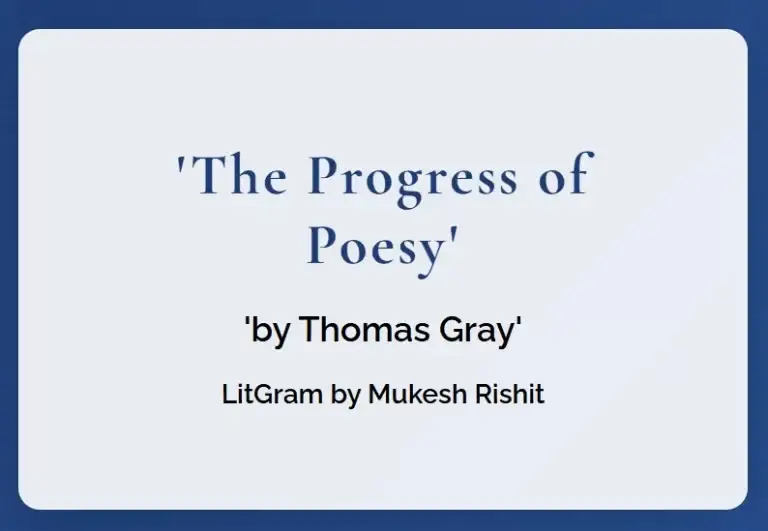Introduction
Thomas Gray’s 1757 poem “The Progress of Poesy” stands as a celebrated work in the canon of English literature. As a complementary piece to his more famous Elegy Written in a Country Churchyard, Gray’s “Progress” charts the evolution of poetic inspiration—from classical beginnings through pastoral idylls to the heights of epic and tragic verse. In this post, we’ll explore:
- Historical context of mid-18th-century England
- Thematic currents and imagery
- Structural analysis
- Quotations and close readings
- Significance in English letters
- Links to Gray’s broader body of work
Historical Context
The Age of Enlightenment and Neo-Classicism
- Intellectual climate: Mid-1700s Britain was dominated by Enlightenment ideals—reason, order, and adherence to classical models.
- Gray’s position: Though steeped in classical learning, Gray often deviated from the strict heroic couplet form, infusing a more musical, contemplative style.
Gray’s Life and Milieu
- Oxford years: Gray wrote “The Progress of Poesy” as part of a set of four odes while at Cambridge, though he never sought publication until later.
- Literary circle: He associated with poets like Horace Walpole and Edward Walpole, helping shape the early Romantic preoccupation with emotion and nature.
Structure and Form
Four‐Part Ode Structure
- Part I: Classical Dawn
- Part II: Pastoral Arcadia
- Part III: Epic Heights
- Part IV: Tragic Close
Gray employs elegiac quatrains (ABAB rhyme) and iambic pentameter, but allows subtle enjambment for a more fluid, musical progression.
Thematic Analysis
1. The Birth of Poetry in Myth and Antiquity
- Invocation of Phoebus (Apollo): “Son of the morning, whose young footsteps glow / Along the steep of heaven, and gild the hills below.”
- Symbolizes divine inspiration and the purity of poetic birth.
- Emphasis on classical origin—Greek and Roman myth as poetry’s ancestral wellspring.
2. Pastoral Interlude: Poetry in Nature
- Gray shifts to rustic shepherd‐poets:“Then first, in glimpses through the parching soil, / The small blue violet forgot to smile.”
- Themes of innocence, simplicity, and harmonious union of man and nature anticipate Romantic pastoral.
3. The Ascent to Epic and Heroic Verse
- The ode celebrates Homer and Virgil, marking poetry’s epic culmination:“Through all Olympus’ long‐resounding bounds / The voice of Sorrow calls her slaughtered sons_.”
- Epic as a community’s collective memory—poetry as cultural cornerstone.
4. The Twilight of Tragedy
- Finally, Gray examines how poetry records human fallibility, grief, and moral lessons.
- The tragic turn functions as a “moral elegy”, preparing ground for his later Elegy.
Close Readings & Key Quotations
| Section | Key Quote | Commentary |
|---|---|---|
| Classical Dawn | “While organs all resound, and angels strike / The golden lyre with touch divine.” | Divine music imagery underscores the sacred origin of poetic art. |
| Pastoral Arcadia | “And youth, grown wise by time, half‐knowing why, /Will lend a pensive grace to every sigh.” | Bittersweet reflection—pastoral beauty tinged with mortal awareness. |
| Epic Heights | “From great Achilles to the basso shore” | References to Homeric heroes emphasize poetry’s function as historical narrative. |
| Tragic Close | “So fades the lovely bloom of youthful grace, / Yet weep not for the faded flower’s face.” | Mourning beauty’s transience, foreshadowing the universal elegiac voice. |
Significance in English Literature
Influence on Romantic Poets
- Gray’s blend of classical form with emotional depth directly influenced Wordsworth, Coleridge, and Keats.
- His lyrical precision became a model for 19th-century British poetry.
Precursor to the Modern Ode
- “The Progress of Poesy” re-energized the ode form in English, paving the way for Keats’s Ode to a Nightingale and Shelley’s Ode to the West Wind.
Reflections in Gray’s Other Works
- Elegy Written in a Country Churchyard: Extends the elegiac mood, focusing on mortality and rural life.
- Odes on Various Subjects: Gray’s three other odes (to Music, on Eton College) explore similar themes of memory, time, and idealized youth.
Why “The Progress of Poesy” Still Matters Today
- Timelessness of Inspiration: The poem maps the universal creative impulse.
- Interplay of Form and Feeling: Gray’s measured style balances restraint with lyrical beauty.
- Cultural Memory: It reminds us that poetry evolves with society, from myth to modern expression.
Conclusion
Thomas Gray’s “The Progress of Poesy” remains a landmark in English verse—bridging the classical and Romantic eras, and articulating poetry’s spiritual and cultural journey. By weaving divine myth, pastoral calm, heroic grandeur, and tragic wisdom, Gray crafts an ode that not only surveys poetry’s past but points toward its future.
Whether you’re a student of 18th-century literature or a lover of poetic craft, revisiting Gray’s ode offers rich insights into how verse shapes and reflects human experience.
Further Reading & References
- Gray, Thomas. Poems by Mr. Gray (1768) – first collected edition
- Key secondary studies:
- William L. Pritchard, Thomas Gray: A Life
- Roy Porter, Thomas Gray and the Culture of the Enlightenment
- Explore online resources:
- Eighteenth-Century Poetry Archive (ECPA)
- The Oxford Text Archive
Ready to deepen your exploration? Share your thoughts on Gray’s ode in the comments below!


